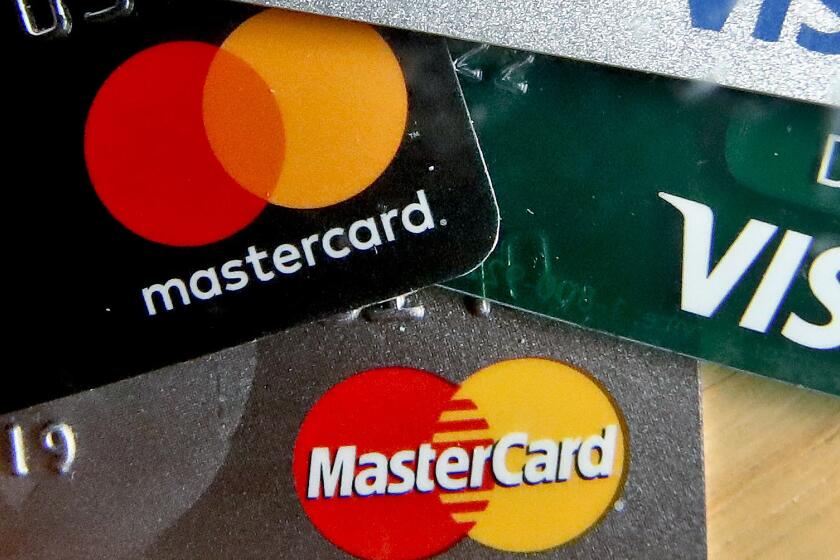Column: Wells Fargo says its promises to restore consumer trust were just ‘puffery.’ But they look more like lies
- Share via
If you’ve ever wondered how businesses can get away with making transparently false or deceptive claims about themselves or their products — “The Best Tasting Juice in America,” Wrigley’s gum is “for whiter teeth, no matter what,” etc., etc. — the answer is an all-purpose legal dodge known as the “puffery” defense.
Simply put, judges and regulators have ruled that when a business makes a claim that is either vague or so obviously inflated that people simply won’t believe it, that’s “puffery,” and not actionable in court.
Wells Fargo, which is struggling to rebuild its reputation for integrity after a string of scandals involving consumer rip-offs, is testing the limits of the “puffery” defense. In a legal filing last week aimed at getting a shareholder lawsuit dismissed, the company asserted that statements that the bank was working to “restore trust” among its customers and “trying to be more transparent” about its scandals — statements made by its chief executive, Tim Sloan — were, well, just puffery.
We’ll probably err on the side of overcommunicating as opposed to undercommunicating.
— Wells Fargo CEO Tim Sloan in January 2017, months before disclosing a new scandal
The filing says these were generic statements “on which no reasonable investor could rely.” Therefore, even though the bank’s stock price fell sharply when evidence emerged that they were false, investors don’t have grounds to sue for their losses.
“This is just another example of corporate actors making statements to the market, and then trying to avoid liability for the representations they made,” says Darren Robbins, the San Diego lawyer bringing the shareholder suit.
If it sounds like a strange thing for a bank to say when it’s trying to present itself as a paragon of rectitude — in essence, “We can’t be sued because no one believed us anyway” — just wait. It gets stranger.
Wells Fargo says that even though the statements by its management fall within the legal definition of puffery, that doesn’t mean they’re untrue. “Wells Fargo stands behind the statements it made regarding its commitment to transparency and rebuilding trust with its customers,” the bank told me by email. “These statements were true then and remain so today.”
The lawsuit at issue concerns a scandal that erupted in public in July 2017, when it became known that for years Wells Fargo had been charging auto loan borrowers for unnecessary insurance on their vehicles. The lawsuit seeks class certification for all investors who bought the company’s stock from Nov. 3, 2016 — when Sloan announced at an investors conference that he was “not aware” of any undisclosed scandals in sales practices — through Aug. 3, 2018, the day before the bank formally disclosed the auto-loan issues in an earnings report.
The scam at the heart of this case was massively abusive, according to internal reports and assertions in a consumer lawsuit filed last week. Wells Fargo saddled roughly 600,000 auto loan borrowers — disproportionately lower-income customers — with insurance to cover the vehicles that collateralized the loans.
Many borrowers, however, already had insurance, so they didn’t need the additional coverage. Some didn’t even know they were being charged because Wells Fargo didn’t itemize the insurance fees on their loan statements.
When customers made monthly payments on their loans, according to the consumer lawsuit, Wells Fargo applied them in a way that pushed as many as 275,000 customers into delinquency, resulting in some 25,000 improper repossessions. The bank didn’t always fully or promptly refund the fees and late charges it owed the victimized customers, and didn’t always clean up credit reports that had been sullied by its illicit behavior.
Top executives allegedly knew of the insurance problems as early as 2012 but took no action until 2016, when they canceled the insurance program. The bank initially said it would have to spend $80 million to compensate the victims; as of September this year, that figure had risen to about $241 million.
Regulators are justifiably furious. In April, the Consumer Financial Protection Bureau and the Office of the Comptroller of the Currency folded in the auto loan case with an investigation of improper fees Wells Fargo charged to mortgage applicants, and penalized the bank $1 billion for both. It was one of the largest bank fines in history.
The shareholder lawsuit focuses on the efforts by Sloan and his fellow executives to conceal the auto-loan scandal from the public. While they were trying to clean up the splatter from the bank’s most prominent scandal, in which sales representatives secretly opened millions of accounts for consumers in order to meet punishing work quotas, the executives consistently stated that they were investigating high and low to make sure the bank was otherwise clean and would fully disclose anything they discovered.
“We want to leave no stone unturned,” Sloan told investment analysts during a conference call in January 2017. “If we find something that’s important, we’ll communicate that…. I think given our desire to be very transparent, we’ll probably err on the side of overcommunicating as opposed to undercommunicating.”
Yet by then, Sloan had received a report from the consulting firm Oliver Wyman that laid out the auto-loan scandal in great detail.
The scandal stayed out of the public eye until the Oliver Wyman report was leaked to the New York Times, which published a story about it July 27, 2017; Wells Fargo issued a news release fessing up to the matter that very day.
The Senate Banking Committee, to which Wells Fargo had submitted written testimony in November 2016 about the fake accounts but said nothing about the auto loans, hauled Sloan into the dock in October 2017.
“The company, pure and simple, lied to this committee and lied to the public,” Sen. Sherrod Brown (D-Ohio) lectured him. “That it took you … 13 months to disclose such a violation of public trust just makes me incredulous.”
The bank maintained that it did its duty by shutting down the insurance program and notifying regulators as soon as it received the Oliver Wyman report — but that it had no obligation to affirmatively notify the public at that time.
What about Wells Fargo’s repeated assurances that it is moving heaven and earth to be more transparent and regain customers’ trust?
That’s where “puffery” comes in. The defense most commonly arises in connection with advertising, as when the Federal Trade Commission investigates whether an advertising claim is deceptive. Over the years, courts have given businesses ever more latitude to make extravagant claims.
Ultimately, puffery has become defined as “advertising claims that ordinary consumers do not take seriously,” as the Harvard Business Review observed a few years ago. But if that’s so, then what’s the point of advertising?
The FTC has held that claims such as calling one’s product “the best” or even “the world’s best” aren’t legally deceptive, since consumers will discount them as manifestly inflated. In other cases regulators have said that puffery encompasses assertions too vague to be proved true or false, aspirational statements (“We mean to be the best”) or mere opinion.
Marketing experts have found increasingly that consumers can be fooled by such blunt statements — consider how President Trump’s increasingly fervid lies still have their believers — but judges and regulators haven’t consistently gotten tougher on flagrant deception.
Wells Fargo musters most of these arguments in its recent legal filing. Wells Fargo argues that some of the statements by Sloan cited by the shareholder plaintiffs are protected as mere opinion, including his expectation that “probably” the bank will “err on the side of overcommunicating.”
The problem there is that protected opinion generally involves an utterance by a third-party not privy to all the facts, not a statement by a CEO fully conversant with the truth. Sloan was effectively committing Wells Fargo to “overcommunicating” in January 2017 — months after he had been made aware of the auto-loan scandal and months before it was “communicated” to the public.
What may be most important about Wells Fargo’s statements is that they plainly were taken seriously by the public. We know this because the bank’s stock took a hit after the auto loan disclosures, falling nearly 3.1% from its close July 26, 2017, through Aug. 4, 2017, adjusted for an Aug. 2 dividend, a sizable drop for a period of just over a week. Wall Street analysts were withering about the bank’s delay in disclosing the new scandal. “Another hit to management’s credibility,” an analyst at Evercore ISI judged — and he was far from alone.
That reaction demonstrates that investors had taken the bank’s promises of transparency and integrity very seriously indeed — the opposite of how people react to “puffery.”
Wells Fargo may well skate by relying on the technicality of the puffery defense, especially if it draws a tolerant judge or jury. But it’s hard to conclude that Sloan, his fellow executives and the bank’s directors weren’t being deceitful when they promised transparency while drawing a curtain over a major scandal. Of all the companies in the land, Wells Fargo owed it to the public to keep nothing whatsoever hidden. Instead, it dug itself an even deeper hole.
But we’ve all become inured to outright lying by businesses and politicians. If there’s any lesson to be learned from the deception practiced in both spheres in recent years, it’s that the days of innocent “puffery” are over, and our lives and livelihoods hang in the balance when we don’t hold business and political leaders strictly to account. It’s past time for the pendulum to swing back toward truth.
Keep up to date with Michael Hiltzik. Follow @hiltzikm on Twitter, see his Facebook page, or email michael.hiltzik@latimes.com.
Return to Michael Hiltzik’s blog.
More to Read
Inside the business of entertainment
The Wide Shot brings you news, analysis and insights on everything from streaming wars to production — and what it all means for the future.
You may occasionally receive promotional content from the Los Angeles Times.











